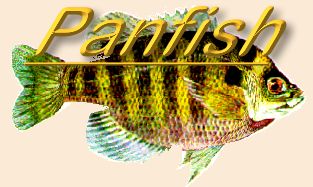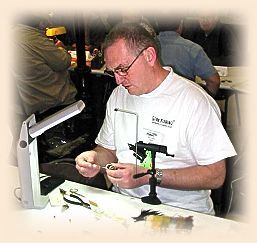|
Went out on a Saturday afternoon to try my luck. The wind
was blowing about 20 mph. I decided on the pond I was going
to so I could be protected by some trees from the wind. The
trees are about 50 feet back from the pond but higher on the
hill so they block the wind fairly well.
I went out with two fly rods. I put a fly on one with a strike
indicator and cast it out so the wind could carry it out over
deeper water to see if any fish we suspending in that area.
With the other rod I tied on a Hares Ear variation, but made with
Muskrat fur as I am all out of Hares Ear right now.
In the book Worlds Best Trout Flies there is a
picture of a Hares Ear Stonefly that has gills on it. In my
warped mind, by my wife's definition, I decided that it might
be worth while to put gills on a regular Hares Ear Nymph (HEN).
So I tied some up with the regular pattern but tied in some
orange feather fibers in the thorax area. I "figured 8" these
in so they would not move as easily. (I did this after I pulled
the first gills out when I went to trim them.)
I decided I wanted to try this fly to see what might be near
the shore. I cast this fly out and let it settle down and then
started retrieving it with very slow rod lifts and then pulling
the line in until is was tight again. On the fourth cast as I
was dropping the rod tip the line sideways I had a bass of about
14" on. When I got the bass in and released I noticed the strike
indicator was moving on the other rods, so I grabbed that rod and
set the hook.
I had a nine inch crappie. I cast this rig out again and let
it drift out farther than I can cast. I watched it for a couple
of minutes and with nothing happening went back to casting the HEN.
About every sixth cast I would hook a bass. They ran from about
eight to twenty inches long. All of them hit hard and were hooked
in the corner of the mouth.
I was surprised that they hit this hard with the ice having been
off for ten days. At the same time I had crappie hitting about
every 5 minutes on the other rod. I was using a Muddler variation
on that rod. I thought it would look more like the size food that
might be in the pond.
The land owner came to the pond and put his flat bottom in to
go fishing. He has all sorts of gadgets on this boat. He does
have two fish finders on it. As he watched the fish finders he
said that it appeared that the fish were circling the pond. He
could mark fish a regular intervals, all going the same way.
This made sense to me because I was casting through the same
area and continued to catch fish. I don't think there are that
many bass in the pond to have that many in the fairly small area
I was covering.
He went to the other side of the pond and fished so we would
not be interfering with each other.
I ended up catching about half the crappie that hit, either
because they hit lightly or because I did not watch that rod
close enough. I think part of it was them hitting lightly
because I lost several as I tried to get them to shore. The
ones I did land were all hooked in the lips and not deep in
the mouth.
The main thing I saw about the crappie was the increase in size.
Last year I caught a lot (around 300) of fish that were about
four inches long. This year they are running about nine inches
long.
The growth must be due to more food for fewer fish. I also
have talked the land owner into leaving the largest bass in
the pond. He likes the improvement in the panfish size because
he brings his grandkids to fish in the pond. Catching bigger
fish makes them happier.
I know some of you may not like strike indicators; you may say it
is bobber fishing. My position is, I use them. It is part of the
variation that we all have to enjoy this wonderful method of fishing.
I am not a purist in fly fishing.
Hope you can get out on the water.
~ Rick (written March 26th, 2003)
|



